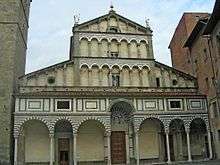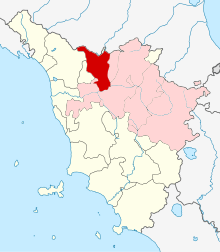Roman Catholic Diocese of Pistoia
| Diocese of Pistoia Dioecesis Pistoriensis | |
|---|---|
 Pistoia Cathedral | |
| Location | |
| Country | Italy |
| Ecclesiastical province | Florence |
| Statistics | |
| Area | 821 km2 (317 sq mi) |
| Population - Total - Catholics |
(as of 2004) 217,515 215,000 (98.8%) |
| Parishes | 161 |
| Information | |
| Denomination | Catholic Church |
| Rite | Roman Rite |
| Established | 3rd Century |
| Cathedral | Basilica Cattedrale di S. Zenone |
| Current leadership | |
| Pope | Francis |
| Bishop | Sede Vacante |
| Emeritus Bishops | Mansueto Bianchi |
| Map | |
 | |
| Website | |
| www.diocesipistoia.it | |
The Italian Catholic Diocese of Pistoia (Latin: Dioecesis Pistoriensis) is located in the Province of Florence. It has existed since the third century. From 1653 to 1954, the historic diocese was the diocese of Pistoia and Prato. The Diocese of Prato has been separate from 1954.[1][2]
The diocese is a suffragan of the archdiocese of Florence.
History
The name of Pistoia appears for the first time in history in connexion with the conspiracy of Catiline (62 BC), but it was only after the sixth century that it became important; it was governed, first, by its bishops, later by stewards of the Marquis of Tuscany. It was the first to establish its independence, after the death of Countess Matilda, and its municipal statutes were the most ancient of their kind in Italy.
Pistoia claims to have received the Gospel from St. Romulus, the first Bishop of Fiesole. The first mention of a Bishop of Pistoia is in 492, though the name of this prelate, like that of another Bishop of Pistoia, referred to in 516, is unknown.
In 1653, Prato was made a diocese, and united, œque principaliter, with Pistoia; as early as 1409, Florence asked for the creation of a diocese at Prato, on account of the dissensions of the collegiate church of Prato with the Bishops of Pistoia; and in 1460, it had been made a prelatura nullius, and given, as a rule, to some cardinal, in commendam.
Bishops
Diocese of Pistoia
Erected: 3rd Century
Latin Name: Pistoriensis
Metropolitan: Archdiocese of Florence
- The first historically known bishop is Joannes (700).
- Leo (1067), important in the schism of Emperor Henry IV;
- Jacobus (1118–41);
- Atto (1135–53);
- Bonus (1189), author of De cohabitatione clericorum et mulierum;
- Giovanni Vivenzi (1370);
- Bl. Andrea Franchi, O.P. (1381–1400 Resigned)
- Matteo Diamanti (1400–1425 Died)
- Ubertino Albizi, O.P. (1426–1434 Died)
- Donato de' Medici (1436–1474 Died)
- Niccolò Pandolfini (1474–1518 Died)
- Lorenzo Pucci (1518–1518 Resigned)
- Antonio Pucci (cardinal) 1518–1541 Resigned)
- Roberto Pucci (1541–1546 Appointed, Bishop of Melfi e Rapolla)
- Francesco da Galliano (1546–1559 Died)
- Giovambattista Ricasoli (1560–1572 Died)
- Alessandro Ottaviano de' Medici (1573–1574 Appointed, Archbishop of Florence)
- Ludovico Antinori (1574–1575 Appointed, Bishop of Pisa)
- Lattanzio Lattanzi (1575–1587 Died)
- Ottavio Abbiosi (1587–1599 Resigned)
- Fulvio Passerini (1599–1599 Died)
- Alessandro del Caccia (1600–1649 Died)
- Francesco Nerli (seniore) (1650–1652 Appointed, Archbishop of Florence)
Diocese of Pistoia e Prato
Name Changed: 22 September 1653
Latin Name: Pistoriensis et Pratensis
Metropolitan: Archdiocese of Florence
- Giovanni Gerini (1653–1656 Died)
- Francesco Rinuccini (Ruccini) (1656–1678 Died)
- Gherardo Gherardi (1679–1690 Died)
- Leone Strozzi (archbishop), O.S.B.[3] (1690–1700 Appointed, Archbishop of Florence)
- Francesco Frosini (1701–1702 Appointed, Archbishop of Pisa)
- Michele Carlo Visdomini Cortigiani (1703–1713 Died)
- Colombino Bassi, O.S.B. (1715–1732 Died)
- Federico Alamanni (1732–1775 Died)
- Giuseppe Ippoliti (1776–1780 Died)
- Scipione de' Ricci[4] (1780–1791 Resigned)
- Francesco Falchi Picchinesi (1791–1803 Died)
- Francesco Toli (1803–1833 Died)
- Angiolo Maria Gilardoni (1834–1835 Died)
- Giovanni Battista Rossi (1837–1849 Died)
- Leone Niccolai, O. Cart. (1849–1857 Died)
- Enrico Bindi (1867–1871 Appointed, Archbishop of Siena)
- Niccola Sozzifanti (1871–1883 Died)
- Donato Velluti Zati di San Clemente (1883–1885 Resigned)
- Marcello Mazzanti (1885–1908 Died)
- Andrea Sarti (1909–1915 Died)
- Gabriele Vettori (1915–1932 Appointed, Archbishop of Pisa)
- Giuseppe Debernardi (1933–1953 Died)
Diocese of Pistoia
25 January 1954: Split into the Diocese of Pistoia and Diocese of Prato
- Mario Longo Dorni (1954–1985 Died)
- Simone Scatizzi (1981–2006 Retired)
- Mansueto Bianchi (2006–2014 Resigned)
- Fausto Tardelli (2014–)
References
- ↑ "Diocese of Pistoia" Catholic-Hierarchy.org. David M. Cheney. Retrieved October 7, 2016
- ↑ "Diocese of Pistoiax" GCatholic.org. Gabriel Chow. Retrieved October 7, 2016
- ↑ Abbot of Vallombrosa, who founded the seminary of Pistoia
- ↑ Ricci was famous on account of the Synod of Pistoia which he convened in 1786, and which Pope Pius VI afterwards condemned.
Books
- Cappelletti, Le Chiesa d'Italia, XVII
- Rosati, Memorie per servire alla storia des vescovi di Pistoia
acknowledgment
![]() This article incorporates text from a publication now in the public domain: Herbermann, Charles, ed. (1913). "article name needed". Catholic Encyclopedia. New York: Robert Appleton.
This article incorporates text from a publication now in the public domain: Herbermann, Charles, ed. (1913). "article name needed". Catholic Encyclopedia. New York: Robert Appleton.
Coordinates: 40°37′00″N 16°09′00″E / 40.6167°N 16.1500°E